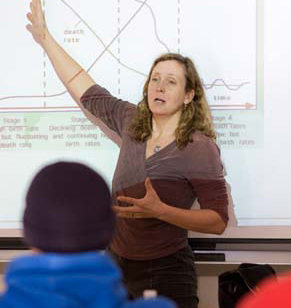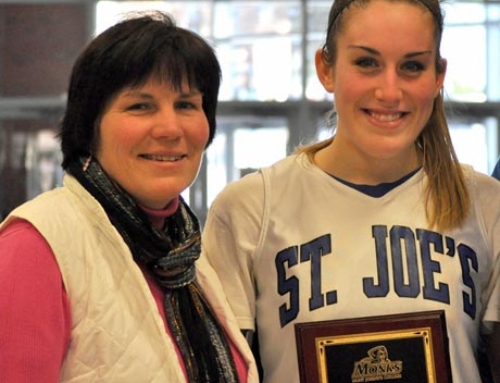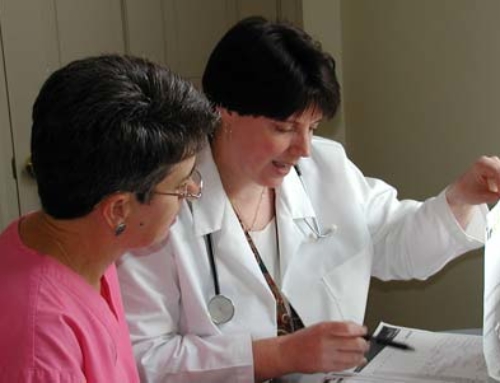 Required class about Planet Earth proved to be ahead of its time
Required class about Planet Earth proved to be ahead of its time
Before sustainability became a buzz word and colleges nationwide wholly embraced the green movement, Saint Joseph’s stood on unique ground nine years ago when it decided to require an environmental science course for all juniors.
The course came about at the urging of the academic dean at the time, Dr. Daniel Sheridan.
“Dan was ahead of his time,” says Dr. Jeanne Gulnick, the campus sustainability coordinator and one of the faculty members who teaches the course, called Ecology and the Environmental Challenge. Even now, she doesn’t know of another college that requires a kindred course.
Just as one should study Shakespeare as a part of a liberal education, one should study the environment, says Sheridan, who is now a theology professor on campus and head of the online theology program.
“We ought to know the Earth where we live,” he states. “We’re part of the whole.”
Sheridan’s inspiration for developing the course came from Father Thomas Berry, a Catholic ecotheologian and cultural historian. Berry devoted his career to understanding and describing how Western culture was spiritually estranged from the Earth, especially in the face of the modern technological culture. He considered nature as the revelation of ultimate and sacred reality.
Sheridan had worked closely with Berry at the Riverdale Center of Religious Research just north of New York City, had done his dissertation under Berry’s direction at Fordham University and considered him a mentor. They had talked about how colleges should help students more clearly understand environmental perspectives.
In 1999, Sheridan proposed that Ecology and the Environmental Challenge become part of the Core Curriculum for the 21st Century that he envisioned on campus. But while the Faculty Senate did not approve some of the more sweeping changes, it did okay requiring the new ecology class. In the fall of 2001, it was offered for the first time.
Although conceived as a science course rooted in Earth’s interrelated physical systems, energy and matter, Sheridan believed the new course would also spill over into policy areas. Indeed, it has evolved to consider the big environmental problems. In so doing, it pulls in ethics, sociology, economics, even theology.
Gulnick believes students can be inspired to protect the environment for many reasons, and in class she gives students the chance to discuss those perspectives. “Their value systems can justify why we should protect it,” she says. (In fact, the Catholic Church has a strong stance on protecting the environment, she says, noting Pope Benedict XVI strongly denounced the lack of action taken in Copenhagen during the global climate change summit late last year.)
Whatever the students’ values, they quickly grasp that sustainability is the underlying theme of the course. One of Gulnick’s class goals is getting her students to understand that a planet of 6.8 billion people can’t sustain life if we all consume resources in the way the developed world has up until now. She wants the students to see how we as individuals can lead society to a sustainable future.
On a less global note, Gulnick obtained a Dorr Foundation grant in 2009 to examine energy use right here on campus, so students have been able to use their surroundings as a living laboratory for the course. (In fact, Sheridan originally intended the course to inventory the campus environment and build greater familiarity with the local bioregion.) Gulnick is trying to create a kind of ecological literacy, whereby students not only learn about the energy use of specific appliances and equipment, but also look at issues such as land conservation or coastal eutrophication.
Greg Teegarden, who has been teaching Ecology and the Environmental Challenge since 2002, likes the classes’ connection to current events, which requires “constant attention to environmental news and updating of class material.” He points to a story like climate change as an example. “We went from 2000 to 2010 with major improvements in our understanding of the science, the degree to which we can attribute change to human causes, and the pace of change, like Greenland’s melting glaciers,” he says.
Course evaluations range from “I don’t think that this course should be required for all students” to “This was one of the most useful and educational classes I have taken at this school.” According to Teegarden, many evaluations state that the course is applicable to everyday lives and lends a new appreciation for the importance of caring for the environment. “They do take it in, and I think generally more so than the average required class,” he says. “Of course you’re asking a biased source, but I still think it’s true.”
Gulnick says she knows at least some students find the course life-changing. She recently got an e-mail from former student Susan Muzzy ’11, who told her she had just watched a long show on the History Channel about mercury levels in tuna and also read an interview in Time magazine with agribusiness critic Michael Pollan. She wrote: “Had it not been for your course, I would not have watched the whole hour about tuna, and I would not have read an interview with Michael Pollan. Aside from some of my education courses, your course has had the greatest impact on me as a scholar and as a citizen. I find myself making connections to class all the time and I have a greater, newfound curiosity with all of the issues we talked about in class.”



